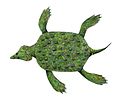| Pantosaurus Temporal range: Late Jurassic, | |
|---|---|
 | |
| Restoration | |
| Scientific classification | |
| Domain: | Eukaryota |
| Kingdom: | Animalia |
| Phylum: | Chordata |
| Class: | Reptilia |
| Superorder: | † Sauropterygia |
| Order: | † Plesiosauria |
| Family: | † Cryptoclididae |
| Genus: | † Pantosaurus Marsh, 1893 |
| Species | |
| |
| Synonyms | |
| |
Pantosaurus ("all lizard") is an extinct genus of plesiosaur from the Late Jurassic (Oxfordian) of what is now Wyoming. It lived in what used to be the Sundance Sea. It was originally named Parasaurus ("near lizard") by Othniel Charles Marsh in reference to Plesiosaurus , but that name was preoccupied, and Marsh changed it. [1] [2] The species Muraenosaurus reedii is in fact a junior synonym of Pantosaurus. [3] The holotype YPM 543 is a partial articulated skeleton, partially prepared to yield a distal humerus, four articulated carpals, a fragment of the coracoid, and several isolated cervical vertebrae from the Upper Member of the Sundance Formation. Other material includes USNM 536963, USNM 536965, UW 3, UW 5544 and UW 15938. [4]






